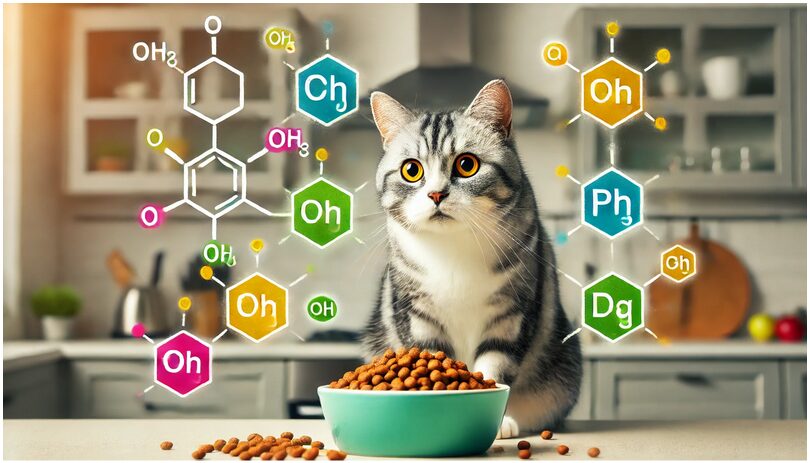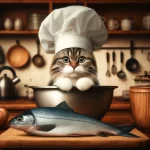When choosing the best food for your cat, it’s natural to prioritize protein content, flavor, and overall nutrition. But have you ever stopped to consider the additives in your cat’s food, particularly phosphates? While phosphates in cat food is pretty common both in wet and dry varieties, recent studies suggest that they could pose hidden dangers to your feline friend’s health. Let’s dive into what phosphates are, why they’re used, and the risks they may carry.
What Are Phosphates?
Phosphates are chemical compounds containing phosphorus, an essential mineral for cats. Phosphorus plays a key role in many bodily functions, including bone health, energy production, and kidney function. However, not all forms of phosphorus are the same. Naturally occurring phosphorus in high-quality meats, organs, and fish is generally safe for cats and necessary for their well-being.
In contrast, inorganic phosphates, which are added to processed foods, are where the concern lies. These phosphates are used as preservatives, flavor enhancers, and texture improvers, making them a common ingredient in commercial cat foods.
Why Are There Phosphates In Cat Food?
The pet food industry uses phosphates for several reasons, including:
- Shelf life extension: Phosphates prevent spoilage, especially in wet foods.
- Flavor enhancement: They make the food taste more appealing to cats, increasing palatability.
- Texture improvement: Phosphates help bind ingredients together, giving canned food that smooth, uniform texture many cats enjoy.
- Nutritional balance: Some pet food manufacturers add phosphates to help meet required dietary levels of phosphorus.
While these reasons might seem harmless, the real issue arises when the amount of inorganic phosphate in the food exceeds what’s considered healthy for cats.
The Hidden Dangers of Phosphates in Cat Food
Excessive amounts of added phosphates can lead to a range of health problems in cats, especially when consumed over time. Here’s why you should be concerned:
1. Kidney Disease Risk
Cats are particularly prone to kidney disease, especially as they age. Phosphorus is regulated by the kidneys, and excess phosphorus intake can lead to an increased burden on these vital organs. High levels of inorganic phosphates are absorbed more readily than natural phosphorus, meaning that they can quickly accumulate in a cat’s system. Over time, this excess phosphorus can cause damage to kidney tissues and contribute to the development or worsening of chronic kidney disease (CKD), a common issue in senior cats.
2. Bone Health Complications
Phosphorus works in tandem with calcium to maintain strong bones. However, an imbalance in phosphorus, particularly from inorganic sources, can throw off this delicate balance. When cats consume too much phosphate, it can lead to calcium depletion, causing weaker bones, joint issues, and even fractures in severe cases.
3. Hyperphosphatemia
Cats with compromised kidney function are at a heightened risk of developing hyperphosphatemia, a condition where phosphorus levels in the blood become too high. This can lead to a cascade of health problems, including:
- Cardiovascular issues such as calcification of blood vessels.
- Bone disorders due to the inability to properly regulate calcium and phosphorus levels.
- Muscle weakness and discomfort.
Once hyperphosphatemia sets in, managing the condition becomes challenging, often requiring dietary changes, medications, or even phosphate binders.
How to Spot Phosphates in Cat Food Labels
Understanding cat food labels can be tricky, but it’s worth becoming familiar with the different names for added phosphates. Look for terms like:
- Sodium phosphate
- Calcium phosphate
- Potassium phosphate
- Phosphoric acid
If you see any of these on the ingredients list, it’s an indication that inorganic phosphates have been added. Generally, the higher these appear on the ingredients list, the more prevalent they are in the formula.
How Much Phosphorus is Too Much?
The ideal phosphorus intake for cats varies depending on their age, health status, and diet, but most experts agree that a phosphorus content of 0.5–1.5% is generally safe for healthy cats. However, for cats with kidney issues, even this can be too much, and lower phosphorus levels are recommended to avoid exacerbating their condition.
If you’re unsure about your cat’s specific needs, consulting your veterinarian is always a good idea, especially if your cat is older or already showing signs of kidney disease.
Choosing a Low-Phosphate Cat Food
If you’re concerned about the phosphate content in your cat’s food, there are steps you can take to limit their exposure:
- Opt for high-quality, natural foods: Look for brands that prioritize fresh, whole ingredients with minimal additives. Foods that are high in meat content but low in fillers are usually better choices.
- Check for low phosphorus levels: Some cat food brands provide phosphorus content on the label or on their websites. Opt for foods with lower phosphorus levels, especially if your cat is older or prone to kidney issues.
- Consider prescription diets: For cats with kidney disease or phosphorus sensitivity, your vet may recommend a renal diet specifically formulated to have reduced phosphorus content.
Conclusion: The Importance of Phosphorus Balance
While phosphorus is essential to your cat’s health, too much of a good thing—especially in the form of inorganic phosphates—can be harmful. Being mindful of the ingredients in your cat’s food and consulting with your veterinarian about your cat’s nutritional needs can go a long way in ensuring their long-term health and well-being.
By taking steps to limit phosphates in cat food, you’re helping to protect your cat’s kidneys, bones, and overall vitality. So next time you shop for cat food, give that ingredients list a second glance—your feline friend will thank you!
Interested in more info on problematic cat food additives, checkout these posts:
Home With Cats, The Scoop on Carrageenan: Understanding Its Role in Cat Food
Home With Cats, The Hidden Danger of Ethoxyquin in Cat Food
Happy Cat Haven, Cat Food Ingredients: What to Feed & What to Avoid







I absolutely love your blog and find a lot of your post’s to be precisely what I’m looking for. Does one offer guest writers to write content for you personally? I wouldn’t mind creating a post or elaborating on a lot of the subjects you write in relation to here. Again, awesome blog!
Wow, marvelous blog layout! How long have you been blogging for? you made blogging look easy. The overall look of your website is great, let alone the content!
Hi there, I found your website via Google while looking for a related topic, your web site came up, it looks good. I have bookmarked it in my google bookmarks.